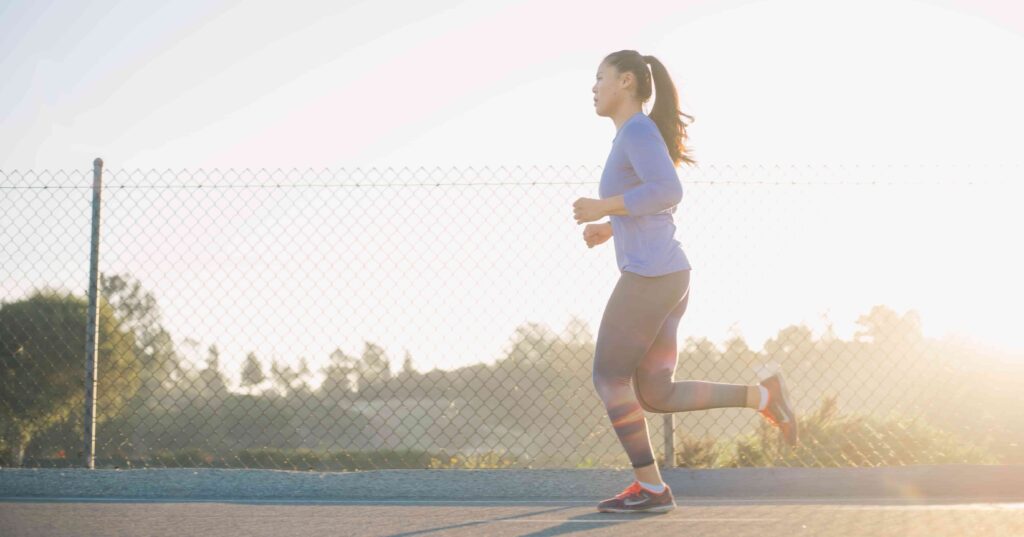
Walking is one of the simplest and easiest forms of exercise that can really benefit your health. This is particularly true if you are suffering back pain or pelvic pain. We’ll explore the benefits of walking and how it can do wonders for your spine and back pain.
Movement & walking is life
There’s no doubt about it, we are designed to move, especially to walk. It’s said that physiologically, our bodies have evolved to walk relatively long distances, just like our hunter gather days when we would hunt and forage for food. Top evolutionary scientist, Dr Daniel Lieberman, states that typically humans walked around 6 miles a day in search of food. We evolved to walk on two legs efficiently, a very different story to our distant ape ancestors who expend much more energy moving about on land.
We’ve evolved big toes, angled thighs and a curvature in our lower back, all to help us efficiently walk on two legs. We could say that we have evolved over millions of years to be able to walk with minimal effort and with ease. Our bones, joint and postural frame are perfectly adapted to walking.
Modern life isn’t designed to suit our health physiology
It goes without saying, modern life is designed to make our lifestyles comfortable and easy. We have chairs and beds for comfortable sitting and sleeping, cars to get us from A to B without much exertion, and modern shoes that protect our feet. However, all these modern comforts come at a cost. We need to stress our bodies to make them strong. Children need to play and move to build strong muscles and bones. In much the same way, if we don’t exercise our joints and muscles, they can atrophy and weaken.
The problem with sitting
It’s been said that sitting is the new smoking. Prolonged sitting day in and day out can have deleterious effects on our health, not only for our spines, but for our circulation, metabolism and cognitive function. Sitting can increase the weight and load bearing in the spine by up to 50%. Anatomically, we are designed to squat, not sit in the position that chairs encourage. When we squat, out hips open, the knees and muscles are challenged and strengthened, and the back is stretched.
I encourage people to squat regularly throughout the day, as it’s one of the best ways to release back tension and relieve the hips.
Wolff’s Law and walking
Wolff’s law states that healthy bones with adapt to stress and strain that is placed on it. When we exercise, these heavier loads stress the joints and bones, which causes them to adapt and strengthen over time. This is very important for children to develop strong healthy bones. Loading the joints increases bone density. Our body’s are constantly adapting to the stresses placed on it, so the more we more and exercise, the stronger our body becomes. Conversely, when we spend long hours every day being inactive, like sitting at the office, our bodies adapt to this and become weaker, stiffer and less functional. We can develop back pain, hip and knee pain, and neck pain. Our posture changes too.
My personal favourite form of exercise is yoga, since it challenges the spine and joints in many different ways, including many movements that we typically don’t perform in our day to day movement. Things like side bends, back bends and twists.
Back to walking
Now that we understand the importance of movement and exercise for joint, muscle and bone health, we can see how walking can be so beneficial for our spines. Walking is a natural movement for the pelvis, hips and back. It will naturally help disperse tension, decrease stiffness and open up the joints, particularly in the pelvis and hips. Whilst 6 miles a day is a lot, aim for the recommended 10, 000 steps a day. This will benefit our cardiovascular health too.
Running
Lieberman states that we have evolved to run over long distances. This is how we hunted prey. Hunters would persistently follow their prey over long distances until they reached exhaustion. We weren’t designed to sprint, but long distances suit us well. We have evolved certain features that our ancient human relatives and apes don’t share. Like arches in the feet and long tendons like the achilles, designed to act like springs to propel as forward. We have large buttock muscles (the gluteus maximus) that activates when we run, but not when walking.
Lieberman states ‘Walking and running are essential to switch on repair and maintenance in our bodies. Exercise breaks down muscles and triggers inflammation, but this in turn switches on anti-inflammatory and repair mechanisms. The long-term effect is less inflammation all over the body. Exercise also keeps off belly fat, which in itself is a major cause of inflammation and other problems. “We evolved to be physically active. It is important for almost every system in the body,”’.
Move, walk, run!
From Lieberman’s statement above, we can clearly see how we are made to walk and run. Our entire physiology is dependent on it if we are to be healthy. We even produce feel good hormones and molecules like dopamine when we exercise. When we don’t exercise, our mental health suffers tremendously.
For more information, including Scoliosis, click here.
References
King, A., Evolved to run – but not to exercise. [Online]. The Irish Times. 03/12/2020, accessed 16/09/22. Available at https://www.irishtimes.com/news/science/evolved-to-run-but-not-to-exercise-1.4412604.
